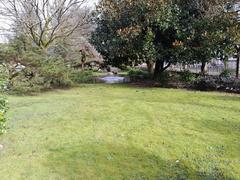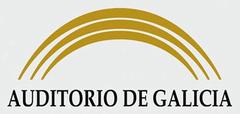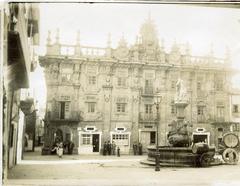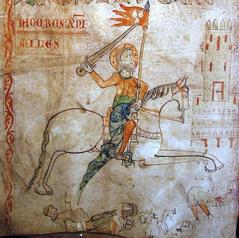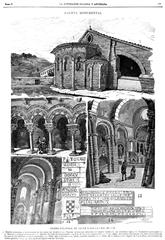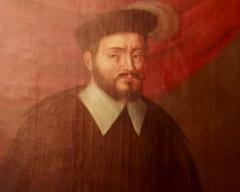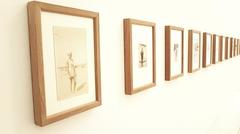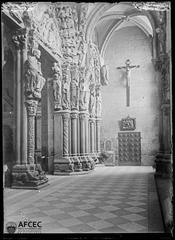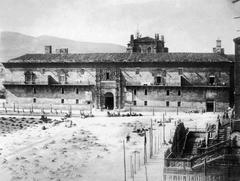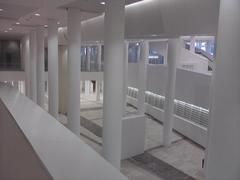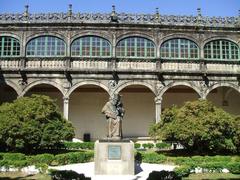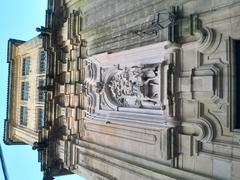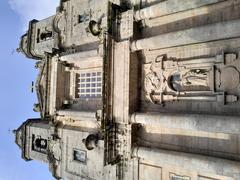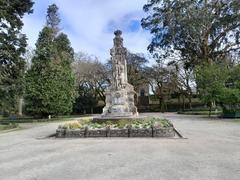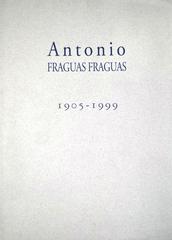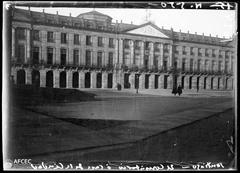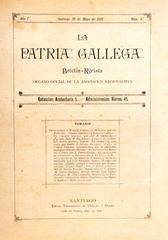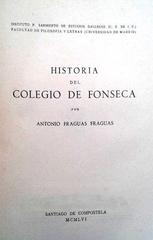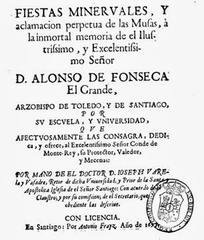
Visiting the Church of San Fiz de Solovio, Santiago de Compostela, Spain
Date: 04/07/2025
Introduction: A Portal to Santiago’s Spiritual and Architectural Origins
Nestled in the heart of Santiago de Compostela’s historic center, the Church of San Fiz de Solovio stands as the city’s oldest parish church and one of its most evocative religious monuments. Founded in the 9th century—predating even the iconic Cathedral of Santiago—it has witnessed a millennium of transformation, from its humble beginnings as a rural shrine to a vibrant parish at the crossroads of pilgrimage routes. The church’s name, honoring Saint Felix and the Latin “Solovio” (place of the sheep), hints at its pastoral origins and deep connection to the genesis of Santiago as a pilgrimage center (Turismo de Santiago; Fundación Jacobea).
San Fiz de Solovio’s architectural tapestry is a harmonious blend of Romanesque, Gothic, Renaissance, and Baroque elements. Its compact yet richly adorned interior preserves centuries of sacred art, including a rare 14th-century polychrome tympanum and gilded Baroque altarpieces. The church’s role as a spiritual waypoint, its ongoing liturgical life, and its proximity to major city landmarks make it an essential visit for pilgrims, history enthusiasts, and cultural travelers alike (Santiago Turismo; Galicia Guide).
This guide details everything you need to know for a rewarding visit: historical background, opening hours, entry information, accessibility, travel tips, and nearby attractions.
Table of Contents
- Introduction
- Historical Overview and Architectural Evolution
- Architecture and Artistic Highlights
- Visiting Information
- Pilgrimage and Cultural Significance
- Practical Visitor Tips
- Frequently Asked Questions (FAQ)
- Summary and Final Tips
- References and Further Reading
Historical Overview and Architectural Evolution
Early Origins and Foundation
San Fiz de Solovio traces its foundation to the early 9th century. According to tradition and medieval chronicles, it was here that the hermit Paio (Pelayo) experienced the visions that led to the discovery of the tomb of the Apostle James—a moment that sparked Santiago de Compostela’s rise as a major Christian pilgrimage destination. The name “San Fiz” references Saint Felix, while “Solovio” comes from the Latin “solo ovium,” meaning “place of the sheep,” reflecting the area’s rural beginnings (Turismo de Santiago; Galicia Guide).
Romanesque Construction and Medieval Expansion
The present church structure was largely built in the 12th century, during the surge of Romanesque church construction in Galicia. Characterized by thick granite walls, a semicircular apse, and minimal ornamentation, this phase established the enduring architectural core. Medieval expansions added side chapels and a bell tower to serve the growing community and influx of pilgrims (Turismo de Santiago).
Gothic and Renaissance Modifications
In the late 15th and 16th centuries, San Fiz de Solovio was updated to include Gothic ribbed vaults and pointed arches in the presbytery and chapels, while Renaissance altarpieces adorned the interior. Local guilds and parishioners supported these enhancements, leaving their mark on the church’s evolving style (Turismo de Santiago).
Baroque Transformation and Conservation
The 18th century brought a dramatic Baroque makeover. The main façade was redesigned with ornate pilasters and volutes, and a striking bell gable (espadaña) replaced the earlier tower. Inside, the main altar was updated with elaborate stucco, gilded woodwork, and expressive sculptures, reflecting Santiago’s Baroque renaissance (Santiago Turismo).
Modern Restoration and Discoveries
Ongoing conservation efforts in the 20th and 21st centuries have stabilized ancient masonry, revealed medieval tombs, and restored fresco fragments. Recent archaeological work has uncovered evidence of pre-Romanesque and possibly Visigothic structures beneath the nave, as well as funerary inscriptions that speak to the church’s centuries-long role as a burial site for local notables (Galicia Guide).
Architecture and Artistic Highlights
Exterior Features
- Romanesque Facade and Portico: The 12th-century stone portal features a polychrome tympanum from 1316, depicting the Adoration of the Magi—a rare medieval artwork in Galicia (Santiago Turismo).
- Baroque Bell Gable: The 18th-century addition by Simón Rodríguez crowns the church with dynamic lines and decorative finials, a hallmark of Galician Baroque architecture.
- Location: At Praza de San Fiz de Solovio, adjacent to the Mercado de Abastos, the church is easily reached on foot from Santiago’s main squares (InTravel).
Interior Features
- Single Nave and Chapels: The modest nave and side chapels reflect early medieval design. The Baroque main altar, dedicated to Saint Felix, showcases twisted columns and gilded details (Wikipedia).
- Notable Artworks: The 14th-century polychrome tympanum, gilded Baroque altarpieces, and the Renaissance tomb of Cardinal Lopo González de Carballido are among the artistic highlights (Wikipedia).
- Liturgical Art: The church’s Christmas nativity scene, crafted by local artisans, exemplifies its ongoing community role.
Visiting Information
Opening Hours and Tickets
- Hours: Generally open Tuesday, Thursday, and Saturday, from 10:30 to 13:00. Hours may vary on holidays and for religious events—check the official site or with local tourism offices for updates.
- Entry: Admission is free. Donations are appreciated to assist with conservation.
Accessibility
San Fiz de Solovio is wheelchair accessible, with ramps at the entrance. Some interior areas may have limited access due to historic architecture (InTravel).
Getting There and Nearby Attractions
The church is centrally located and easily accessible by foot from Santiago’s main train and bus stations. Nearby, you’ll find the Mercado de Abastos, the Museum of Pilgrimage, and the Cathedral of Santiago—ideal for combining multiple historical sites in one visit.
Guided Tours and Events
While regular guided tours are not always available, San Fiz de Solovio is frequently featured on local walking tours. Occasional special events and community celebrations, such as the Christmas nativity scene, enhance the visitor experience (Anglican Pilgrim Centre).
Pilgrimage and Cultural Significance
San Fiz de Solovio’s story is intertwined with the origins of the Camino de Santiago. The church is mentioned in the Codex Calixtinus, the 12th-century pilgrimage guide, underscoring its early importance. Today, it remains a spiritual waypoint for thousands of pilgrims who reflect here before reaching the cathedral (Fundación Jacobea; Xacopedia).
The church also plays a vital role in local traditions, such as the Día das Letras Galegas, and serves as a venue for community gatherings and liturgical celebrations (I Love Compostela).
Practical Visitor Tips
- Best Time to Visit: Early mornings or late afternoons for a peaceful experience.
- Dress Code: Modest attire is required; shoulders and knees should be covered.
- Photography: Permitted without flash, but avoid photographing during services.
- Facilities: No restrooms or gift shop on-site, but amenities are nearby at the Mercado de Abastos.
- Safety: The Old Town is generally safe; usual travel precautions apply.
- Language: Spanish and Galician are spoken; English is less common—translation apps or phrasebooks are useful.
Frequently Asked Questions (FAQ)
Q: What are the church’s opening hours?
A: Typically open Tuesday, Thursday, and Saturday, 10:30–13:00. Check ahead for changes on holidays.
Q: Is there an entrance fee?
A: No, entry is free. Donations are welcomed.
Q: Are guided tours available?
A: Occasionally, through local tourism offices or guided walking tours.
Q: Is San Fiz de Solovio wheelchair accessible?
A: Yes, with some limitations due to historic architecture.
Q: Can I take photographs inside?
A: Yes, but avoid flash and respect services.
Summary and Final Tips
The Church of San Fiz de Solovio is a living archive of Santiago de Compostela’s religious, architectural, and artistic heritage. As Santiago’s oldest parish church and a cornerstone of the Camino de Santiago’s history, it offers visitors a profound sense of continuity with the city’s spiritual origins. Free admission, accessibility, and proximity to other major sites make this church a must-see. Enhance your experience by exploring nearby attractions, joining a local tour, or attending a community event.
For the most up-to-date information, download the Audiala app for guided tours and visitor tips, and follow local tourism channels for the latest on events and hours.
References and Further Reading
- Turismo de Santiago: Iglesia de San Fiz de Solovio
- Santiago Turismo: Igrexa de San Fiz de Solovio
- Fundación Jacobea: San Fiz de Solovio, la iglesia en la que comenzó todo
- I Love Compostela: San Fiz de Solovio Church
- Anglican Pilgrim Centre: San Félix de Solovio
- Galicia Guide: San Fiz de Solovio









